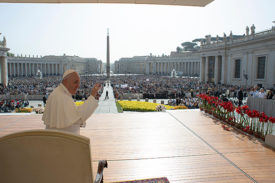By Charles Collins

(Crux) – “Lannister, Targaryen, Baratheon, Stark, Tyrell – they’re all just spokes on a wheel. This one’s on top, then that one’s on top, and on and on it spins, crushing those on the ground .. I’m not going to stop the wheel. I’m going to break the wheel.”
In the controversial final season of ‘Game of Thrones,’ it was hard to tell if Daenerys Targaryen’s pledge from season five of the popular HBO series came to fruition.
Not to give away too many details and spoil the ending for those who still haven’t seen it, let’s just say the series ends with major changes for Westeros, but the figures at the top still seem to have the same last names.
The comparison with the papacy of Pope Francis is hard to miss. Like Daenerys Targaryen, the Holy Father came from a distant continent with a promise to “break the wheel”: In this case, a byzantine and often seemingly corrupt Curial structure in the Vatican.
For the great families of Westeros, you could easily substitute the various dicasteries of the Holy See, which often rise and fall in importance based upon who happens to be in charge at the time.
From the beginning, Pope Francis has been willing to make major changes, beginning with instituting a Council of Cardinals made up primarily of the archbishops of dioceses as opposed to the stalwarts of the Roman Curia. He has instituted various financial reforms, promulgated legislation on child sex abuse, and streamlined the Curia.
For those working at the various communications offices and pontifical councils that have been consumed in his wake, it even seems the pontiff has access to the dragons Daenerys Targaryen used to sweep aside those who stood before her.
This week, the Vatican’s anti-money laundering watchdog agency has released its annual report, citing “significant achievements” both in terms of the reporting of suspicious activity and a tightening of regulations. Earlier this month, the Holy Father issued Vos Estis Lux Mundi, strengthening reporting standards for clerical sex abuse. Even more significantly, in just a matter of weeks, a new constitution for the Roman Curia is expected to be published, which its designers have insisted will reform the entire culture of the Vatican, placing missionary zeal over doctrine and power. These reforms are also meant to battle clericalism and call for greater lay participation in the decision-making of the Church.
So, has the pontiff finally broken “the wheel” of the Vatican? As Tyrion Lannister notes to the Mother of Dragons: “It’s a beautiful dream, stopping the wheel. You’re not the first person who’s ever dreamt it.”
Both Sts. Paul VI and John Paul II implemented major Curial overhauls that were in many ways merely cosmetic, leaving the powerhouse Vatican offices of the Secretariat of State, Congregation for the Doctrine of the Faith, and Propaganda Fide largely unscathed (an attempt by Pope Paul VI to split the Secretariat of State was always more de jure than de facto, and Pope John Paul II finally reversed it.)
Now it’s Pope Francis’s turn.
The celebration of financial reforms this week reminded me of a quote: “An approach to respect for public opinion has forced the Pontifical Government to publish some sort of accounts. It does not render them to the nation, but to Europe, knowing that Europe is not curious in the matter, and will be easily satisfied.”
